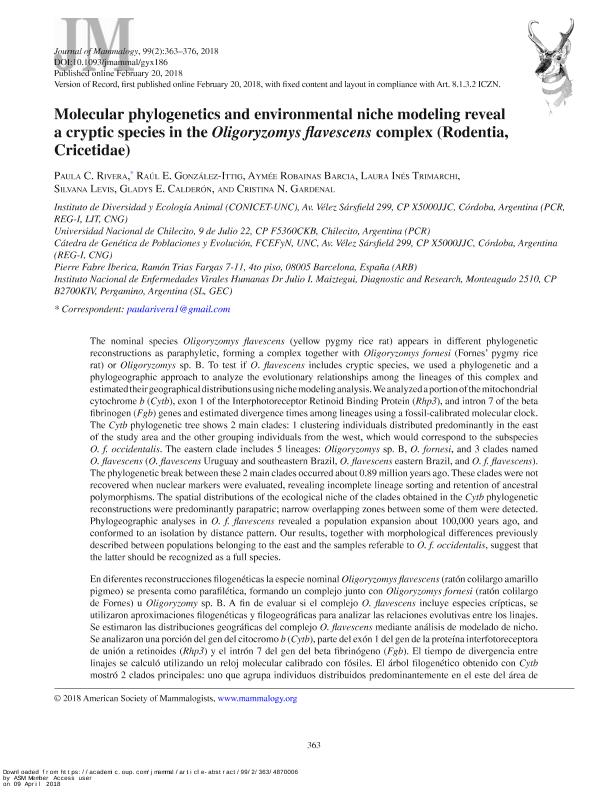Artículo
Molecular phylogenetics and environmental niche modeling reveal a cryptic species in the Oligoryzomys flavescens complex (Rodentia, Cricetidae)
Rivera, Paula Cecilia ; González Ittig, Raúl Enrique
; González Ittig, Raúl Enrique ; Robainas Barcia, Aymée; Trimarchi, Laura Inés
; Robainas Barcia, Aymée; Trimarchi, Laura Inés ; Levis, Silvana; Calderon, Gladys; Gardenal, Cristina Noemi
; Levis, Silvana; Calderon, Gladys; Gardenal, Cristina Noemi
 ; González Ittig, Raúl Enrique
; González Ittig, Raúl Enrique ; Robainas Barcia, Aymée; Trimarchi, Laura Inés
; Robainas Barcia, Aymée; Trimarchi, Laura Inés ; Levis, Silvana; Calderon, Gladys; Gardenal, Cristina Noemi
; Levis, Silvana; Calderon, Gladys; Gardenal, Cristina Noemi
Fecha de publicación:
03/04/2018
Editorial:
Alliance Communications Group Division Allen Press
Revista:
Journal of Mammalogy
ISSN:
1545-1542
e-ISSN:
0022-2372
Idioma:
Inglés
Tipo de recurso:
Artículo publicado
Clasificación temática:
Resumen
The nominal species Oligoryzomys flavescens (yellow pygmy rice rat) appears in different phylogenetic reconstructions as paraphyletic, forming a complex together with Oligoryzomys fornesi (Fornes' pygmy rice rat) or Oligoryzomys sp. B. To test if O. flavescens includes cryptic species, we used a phylogenetic and a phylogeographic approach to analyze the evolutionary relationships among the lineages of this complex and estimated their geographical distributions using niche modeling analysis. We analyzed a portion of the mitochondrial cytochrome b (Cytb), exon 1 of the Interphotoreceptor Retinoid Binding Protein (Rhp3), and intron 7 of the beta fibrinogen (Fgb) genes and estimated divergence times among lineages using a fossil-calibrated molecular clock. The Cytb phylogenetic tree shows 2 main clades: 1 clustering individuals distributed predominantly in the east of the study area and the other grouping individuals from the west, which would correspond to the subspecies O. f. occidentalis. The eastern clade includes 5 lineages: Oligoryzomys sp. B, O. fornesi, and 3 clades named O. flavescens (O. flavescens Uruguay and southeastern Brazil, O. flavescens eastern Brazil, and O. f. flavescens). The phylogenetic break between these 2 main clades occurred about 0.89 million years ago. These clades were not recovered when nuclear markers were evaluated, revealing incomplete lineage sorting and retention of ancestral polymorphisms. The spatial distributions of the ecological niche of the clades obtained in the Cytb phylogenetic reconstructions were predominantly parapatric; narrow overlapping zones between some of them were detected. Phylogeographic analyses in O. f. flavescens revealed a population expansion about 100,000 years ago, and conformed to an isolation by distance pattern. Our results, together with morphological differences previously described between populations belonging to the east and the samples referable to O. f. occidentalis, suggest that the latter should be recognized as a full species.
Archivos asociados
Licencia
Identificadores
Colecciones
Articulos(IDEA)
Articulos de INSTITUTO DE DIVERSIDAD Y ECOLOGIA ANIMAL
Articulos de INSTITUTO DE DIVERSIDAD Y ECOLOGIA ANIMAL
Citación
Rivera, Paula Cecilia; González Ittig, Raúl Enrique; Robainas Barcia, Aymée; Trimarchi, Laura Inés; Levis, Silvana; et al.; Molecular phylogenetics and environmental niche modeling reveal a cryptic species in the Oligoryzomys flavescens complex (Rodentia, Cricetidae); Alliance Communications Group Division Allen Press; Journal of Mammalogy; 99; 2; 3-4-2018; 363-376
Compartir
Altmétricas



